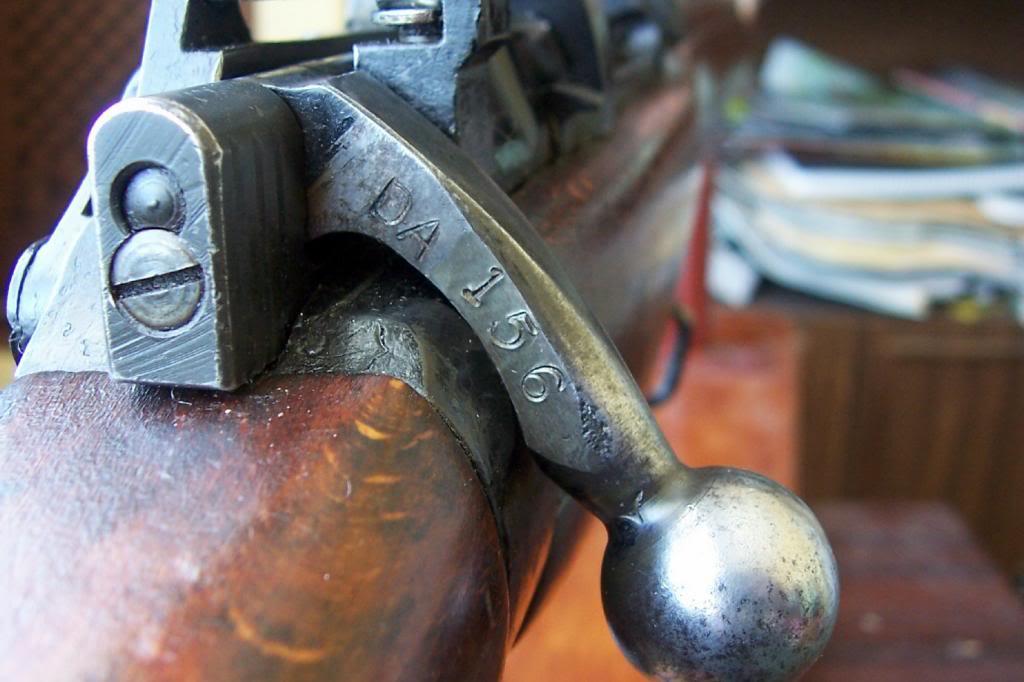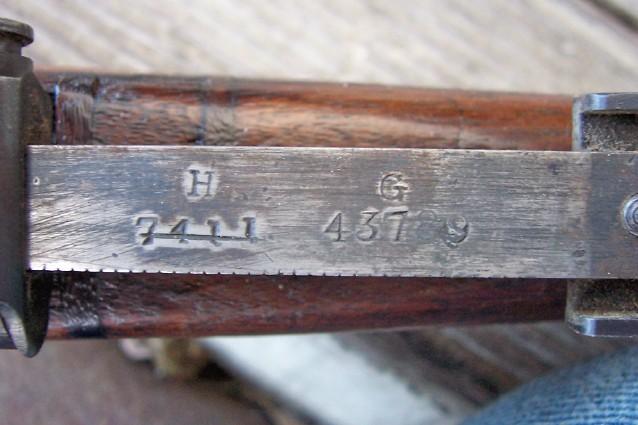-
Legacy Member

Forced match simply means it was re-numbered during refurbishment. It is not the original matching part. So for many collectors it is of less value because it is not original as it left the factory. Almost all Finnish Rifles are technically force matched, but because it is the norm with Finns and they really are completely rebuilt rifles we call it Finn Matching. They renumbered the Russian
Rifles are technically force matched, but because it is the norm with Finns and they really are completely rebuilt rifles we call it Finn Matching. They renumbered the Russian Bolt and Receiver during the build.
Bolt and Receiver during the build.
-
-
04-14-2017 10:44 AM
# ADS
Friends and Sponsors

-
Deceased August 31st, 2020

I used to restore long Lees in much the same way as the Garrand collectors. I would switch out parts to create a rifle with parts of all the same manufacture. I would spend a lot of time and money chasing the right acceptance marks and inspection stamps for a rebuild. All cool and groovey when finished and just as it left the factory!
Then one day I bought a beater of a long Lee Enfield. 1896 LSA. It had been sent to RSAF enfield in 1898 and 1899. A visit to the Birmingham Repair facility in 1903. Then it went over to the Royal Navy through Chatham Naval worlkshop #3 in 1909, had a new barrel fitted before it was shipped out to where it had a rack number applied in 1910.
I determined all this by reading inspection stamps and the little date marks. The thing was a treasure trove for parts for my other rebuilds to make them correct. I had Enfield parts, BSA parts, Sparkbrook parts to switch out and harvest.
It then struck me what I was doing. Looking at this beater, I had a good idea that the Enfield marked nose cap was put on this LSA rifle in 1898 or 99. The rear volley sight and rear barrel band had been switched out by Sparkbrook in 1903. Instead of improving collectability, I was removing the history from the rifle. The next owner would now look at the rework stamps and wonder but never know what had been done in 1899 as now, much of the rework evidence was gone.
So now I take a different approach. If I restore a mix match rifle, it stays mix match. It tells a part of the rifle's story.
Yes, very tempting to switch out and put that BSA marked barrel band on that BSA. But no. Part is parts.
As my collecting experience grows, I can usually tell a restored or de-sportered rifle. Or at least I like to think that I can. I have noticed too many 'all correct' rifles. I am sure that some would be possible, but if everything is correct on a hundred year old service rifle, I am very suspicious.
I only ever restored one rifle that got the full works with new made replacement wood, replacement barrel and a full reblue. All matching manufacture and acceptance mark style. The thing looked like brand new when finished. There were no two serial numbers alike.
The thought did cross my mind that the rifle would be worth more money if it was all matching. But that would be faking, plain and simple, and easy to detect.
The term used for that would be 'humping the rifle'??? I think that one came from Australia ?
?
Last edited by englishman_ca; 04-14-2017 at 11:33 AM.
Reason: spellng and grama
-
The Following 4 Members Say Thank You to englishman_ca For This Useful Post:
-
Advisory Panel


The term "King screw" comes to mind. I never could figure that one out. Maybe we should ask the Queen?
-
-
Legacy Member

As mentioned the term 'Force Matched' mainly applies to Soviet/Russian firearms as when they were rebuilt they tended not to care so much about getting the original parts back together as long as they worked. Literally would stamp out the previous number and stamp the new one in.
firearms as when they were rebuilt they tended not to care so much about getting the original parts back together as long as they worked. Literally would stamp out the previous number and stamp the new one in.
I have mentioned before some of the terms used collecting are a bit... confusing or misleading. This is simply due to a lack of standardization of terms. For example a force matched rifle could be considered all matching as it is matching from service, but it isn't factory original. Some collectors don't consider a force matched rifle all matching (in there case what they consider all matching I would consider factory original).
Collectors are actually one of the few groups actively destroying the history of milsurps in this day and age. Every time you switch out a part to make it 'all correct' (unless the part is broken) you are destroying the history of the firearm. Just because you know that it was switched doesn't mean someone down the road will. Then that incorrect example will become a correct example, which everyone else starts to base their knowledge off of. It is the destruction of history, though the individuals doing it believe it is the preservation of history, which is the scariest part of the whole situation (think the 'committee of public safety' during the French Revolution, and how they actively contributed to the destruction of public safety).
Revolution, and how they actively contributed to the destruction of public safety).
-
Thank You to Eaglelord17 For This Useful Post:
-
Deceased August 31st, 2020

I'll trade you my miss matched Lee Enfield No.1 Mk.I for your force matched No.4 smle.......
-
-
Contributing Member


The term "Force Matched" is not normally used in the Lee-Enfield collecting field and the use of it can cause confusion as noted above by others. I recommend that the term "Force Matched" NOT be used regarding Lee-Enfields, due to the multiple possible meanings and confusion that can result. I believe that it is best to explain a firearm's condition in plain language without using that term.
Likewise, the term "original" is dangerously confusing unless explained in detail (e.g. Original as it left the factory? Original as it left the military as surplus? Original as found in "Bubba's" estate sale? Original as found dug up on a battlefield?)
The term "Force Matched" is commonly used in the Soviet rifles' collecting field to refer to firearms where parts that were changed during an overhaul or other repair in military service, had the old serial number cancelled (usually by striking out), or totally removed (e.g. Bolt handle ground down), and the serial number of the weapon it has now been installed on has been put onto it. The Mosin 91/30 rifle would have serial numbers on butt plate, magazine bottom plate, bolt etc. If a buttplate was changed, the armourer would strike out the old number and stamp in the new rifle's serial number. Sometimes, with both Soviet and with captured German firearms (the latter nicknamed "RC" or "Russian Capture" by collectors), the "new" serial number would be electric-pencilled to show that the part was now mated to a particular firearm (e.g. On Kar98k
Capture" by collectors), the "new" serial number would be electric-pencilled to show that the part was now mated to a particular firearm (e.g. On Kar98k bolts and Mosin 91/30 scope mounts).
bolts and Mosin 91/30 scope mounts).
These were legitimate in-service repairs. Similar parts changes and renumbering occurred on MK.III / MK.III* Lee-Enfields, most often seen by me on the underside of rear sight leaves. We also often see a similar renumbering on scope brackets for the No. 4 MK.I (T) where many brackets were reassigned to one or more other rifles during their service careers. A friend has a No. 4 MK.I (T) where there were three different scope numbers assigned over the years, in-service, to that rifle. The earlier two numbers are cancelled out.
Collectors almost always prefer rifles where the parts only have the original factory marked serial numbers. When parts have been officially changed and renumbered in service, the rifle is still collectible but usually is not as valuable to collectors. Variable factors than can override this are condition e.g. special markings such as desirable national markings, Naval or Air Force issue markings or capture markings) or if a rifle is a rarer variant (e.g. Experimental or a very limited production run.) Thus a Mosin 91/30 or SVT-40 with Finnish "SA" capture markings is usually more valuable than one without such markings.
"SA" capture markings is usually more valuable than one without such markings.
I had six Mosin 91/30 PU sniper rifles. Five of these had arsenal overhaul electric-pencil markings but one rifle did not and an advanced collector zeroed in on that one and added it to his collection. Lee-Enfield collectors usually prefer rifles that have not gone through F.T.R. Americans will understand this as almost all US WWII firearms went through arsenal overhauls and finding a factory original one is a treasure for them. Regarding WNO1958's I do not think that "Forced Match" would not apply as these parts, although they have part numbers and sometimes batch numbers, do not have serial numbers to change. Any firearm could have parts changed in service but if the parts are correct versions and not serial numbered, thus no numbers changed in service, who is to say if it was changed in-service or by a civilian later on? The best term I have seen about such a US rifle is "parts flying together in formation". ;-)
In summary: "Forced Match" is used by collectors of Soviet firearms and "Russian Capture" firearms to refer to parts where the serial nunbered replacement parts were renumbered to match the firearm and this was done in-service. The term is not usually associated with Lee-Enfields or with US firearms.
-
The Following 2 Members Say Thank You to Seaforth72 For This Useful Post:
-
Advisory Panel


In the same vein, why do people refer to the letter and number markings on an arm as "stampings?" A tool named a stamp is used to make the markings. Stampings or pressings (British ) are sheet metal parts formed by pressing the metal in a matching set of dies. Just because a number of people use it, does not make it right.
) are sheet metal parts formed by pressing the metal in a matching set of dies. Just because a number of people use it, does not make it right.
-
Thank You to breakeyp For This Useful Post:
-
Legacy Member

I usually tune out of a thread that has the words force matched.
-
The Following 3 Members Say Thank You to Homer For This Useful Post:
-
Legacy Member

-
-
Deceased August 31st, 2020

So is 'force matching' the same thing as 'humping'?
Or does 'force matching' mean legit in service refurb renumber, and 'humping' means renumbered to deceive, as in a post service renumbering to fake an all matching rifle to increase its resale value?
In order of desirability to collectors, which takes precedence?;-
a. Original to that rifle part with matching serial number.
b. New replacement part numbered to match.
c. New replacement part, no number.
d. Recycled part, old number struck out, renumbered.
e. Recycled part, old number removed, renumbered (force matched, or humped?)
f. Recycled part, old number removed.
g. Recycled part, miss-matched number.
Last edited by englishman_ca; 04-14-2017 at 08:06 PM.
-
Rifles are technically force matched, but because it is the norm with Finns and they really are completely rebuilt rifles we call it Finn Matching. They renumbered the Russian
Bolt and Receiver during the build.














 PM
PM













